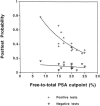Using the free-to-total prostate-specific antigen ratio to detect prostate cancer in men with nonspecific elevations of prostate-specific antigen levels
- PMID: 11089718
- PMCID: PMC1495603
- DOI: 10.1046/j.1525-1497.2000.90907.x
Using the free-to-total prostate-specific antigen ratio to detect prostate cancer in men with nonspecific elevations of prostate-specific antigen levels
Abstract
Background: Prostate-specific antigen (PSA) levels between 4.0 to 10.0 ng/ml have poor specificity in prostate cancer screening, leading to unnecessary biopsies.
Objective: To determine whether the free-to-total PSA ratio (F/T PSA) improved the diagnostic accuracy of these nonspecific PSA levels.
Measurements and main results: MEDLINE searchedwas from 1986 to 1997. Additional studies were identified from article bibliographies and by searching urology journals. Two investigators independently identified English-language studies providing F/T PSA ratio test-operating characteristics data on > or = 10 cancer patients with PSA values between 2.0 and 10.0 ng/ml. Twenty-one of 90 retrieved studies met selection criteria. Two investigators independently extracted data on methodology and diagnostic performance. Investigator-selected cut points for the optimal F/T PSA ratio had a median likelihood ratio of 1.76 (interquartile range, 1.40 to 2.11) for a positive test and 0.27 (0.20 to 0.40) for a negative test. Assuming a 25% pretest probability of cancer, the posttest probabilities were 37% following a positive test and 8% following a negative test. The summary receiver operating characteristic curve showed that maintaining test sensitivity above 90% was associated with false positive rates of 60% to 90%. Methodologic problems limited the validity and generalizability of the literature.
Conclusions: A negative test reduced the posttest probability of cancer to approximately 10%. However, patients may find that this probability is not low enough to avoid undergoing prostate biopsy. The optimal F/T PSA ratio cut point and precise estimates for test specificity still need to be determined.
Figures


Comment in
-
Early detection and aggressive treatment of prostate cancer: groping in the dark.J Gen Intern Med. 2000 Oct;15(10):749-51. doi: 10.1046/j.1525-1497.2000.00816.x. J Gen Intern Med. 2000. PMID: 11089719 Free PMC article. No abstract available.
Similar articles
-
Comparative study of total prostate specific antigen and free to total prostate specific antigen ratio in the diagnosis of prostate cancer.Mymensingh Med J. 2012 Jan;21(1):98-102. Mymensingh Med J. 2012. PMID: 22314462
-
Measurement of prostate specific antigen complexed to alpha1-antichymotrypsin to avoid unnecessary biopsy in patients with serum prostate specific antigen levels 4-20 ng/mL.Int J Urol. 2005 Aug;12(8):721-7. doi: 10.1111/j.1442-2042.2005.01167.x. Int J Urol. 2005. PMID: 16174045
-
Determination of the percentage of free prostate-specific antigen helps to avoid unnecessary biopsies in men with normal rectal examinations and total prostate-specific antigen of 4-10 ng/ml.Eur Urol. 2000 Mar;37(3):289-96. doi: 10.1159/000052358. Eur Urol. 2000. PMID: 10720854
-
[The incidence of the variability of the free PSA/total PSA ratio on the early diagnosis of prostate cancer].Prog Urol. 1997 Jun;7(3):455-63. Prog Urol. 1997. PMID: 9273075 Review. French.
-
Significance of serum free prostate specific antigen in the screening of prostate cancer.J Urol. 1996 Dec;156(6):1964-8. J Urol. 1996. PMID: 8911366 Review.
Cited by
-
Gaucher Disease Diagnosis Using Lyso-Gb1 on Dry Blood Spot Samples: Time to Change the Paradigm?Int J Mol Sci. 2022 Jan 30;23(3):1627. doi: 10.3390/ijms23031627. Int J Mol Sci. 2022. PMID: 35163551 Free PMC article.
-
Variation of a test's sensitivity and specificity with disease prevalence.CMAJ. 2013 Aug 6;185(11):E537-44. doi: 10.1503/cmaj.121286. Epub 2013 Jun 24. CMAJ. 2013. PMID: 23798453 Free PMC article. Review.
-
Prostate cancer: epidemiology and screening.Rev Urol. 2003;5 Suppl 6(Suppl 6):S3-9. Rev Urol. 2003. PMID: 16985974 Free PMC article.
-
Brief report: Free prostate-specific antigen test utilization. Consistency with guidelines.J Gen Intern Med. 2005 Sep;20(9):859-61. doi: 10.1111/j.1525-1497.2005.0181.x. J Gen Intern Med. 2005. PMID: 16117757 Free PMC article.
-
Capitalizing glycomic changes for improved biomarker-based cancer diagnostics.Explor Target Antitumor Ther. 2023;4(3):366-395. doi: 10.37349/etat.2023.00140. Epub 2023 Jun 28. Explor Target Antitumor Ther. 2023. PMID: 37455827 Free PMC article. Review.
References
-
- Mettlin C, Jones G, Averette H, Gusberg SB, Murphy GP, et al. Defining and updating the American Cancer Society guidelines for the cancer related check-up: prostate and endometrial cancers. CA Cancer J Clin. 1993;43:42–6. - PubMed
-
- American Urological Association. Early detection of prostate cancer and use of transrectal ultrasound. American Urological Association 1992 Policy Statement Book. Baltimore, Md: Williams & Wilkins; 1992.
-
- PDQ. (Physician Data Query) [database online]. Bethesda, Md: National Cancer Institute: 1984 – [updated 9/99]. Screening for prostate cancer. Available from: National Cancer Institute; National Library of Medicine, Bethesda, Md: CDP Technologies, Inc., New York, NY; Lexis-Nexis, Miamisburg, Ohio.
-
- American College of Physicians. Screening for prostate cancer. Ann Intern Med. 1997;126:480–4. - PubMed
-
- U.S. Preventive Services Task Force. Guide to clinical preventive services. 2nd ed. Baltimore: Williams & Wilkins; 1996.
Publication types
MeSH terms
Substances
LinkOut - more resources
Full Text Sources
Medical
Research Materials
Miscellaneous
